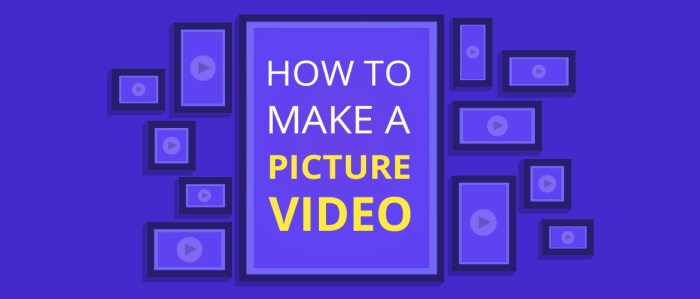Creating How-to Videos opens doors to a world of creativity and education, blending visual storytelling with informative content in a way that captivates audiences and enhances learning experiences. Get ready to dive into the exciting realm of video creation!
Introduction to How-to Videos
How-to videos are instructional videos that guide viewers on how to complete a specific task or learn a new skill. These videos are popular on online platforms like YouTube and social media, providing step-by-step instructions in a visual format.
Importance of Creating How-to Videos
- Engagement: How-to videos are highly engaging and can capture the attention of online audiences more effectively than written instructions.
- Accessibility: Visual demonstrations make it easier for viewers to understand complex concepts or processes.
- Benefits: Including how-to videos in your content strategy can improve your website’s search engine optimization, leading to higher visibility and traffic.
Benefits of Incorporating How-to Videos
- Increased Brand Authority: Providing valuable information through how-to videos can establish your brand as an expert in your industry.
- Enhanced User Experience: How-to videos enhance user experience by offering a more interactive and engaging way to consume information.
- Expanded Reach: How-to videos have the potential to reach a wider audience and attract new viewers who are searching for tutorials or guides.
Planning Your How-to Video
When creating a how-to video, proper planning is essential to ensure that your content is engaging and informative. This includes identifying your target audience, outlining the steps beforehand, and having the right equipment ready to go.
Identifying Your Target Audience
Before you start filming, it’s crucial to understand who your video is intended for. Consider the age group, interests, and knowledge level of your audience to tailor your content accordingly. This will help you create a more focused and impactful how-to video.
Significance of Outlining the Steps
Outlining the steps of your how-to video before hitting record can save you time and ensure a smooth filming process. By organizing your content in advance, you can identify any potential challenges or gaps in information that need to be addressed. This will help you deliver a clear and concise tutorial to your viewers.
Equipment Needed for High-Quality Videos
To create a high-quality how-to video, you’ll need the right equipment. This includes a good camera or smartphone with high-resolution capabilities, a tripod for stability, proper lighting to enhance visibility, and a microphone for clear audio. Investing in quality equipment will elevate the production value of your video and keep your audience engaged throughout.
Scripting and Storyboarding

When creating a how-to video, scripting and storyboarding play a crucial role in ensuring a clear and engaging final product. Let’s delve into the process of scripting the content and the importance of storyboarding in visualizing the video flow.
Scripting the Content, Creating How-to Videos
Scripting involves writing a detailed Artikel of what will be said and shown in the video. Here are some tips for writing a clear and concise script:
- Start by outlining the steps or information you want to convey in the video.
- Use simple and easy-to-understand language to ensure your audience can follow along easily.
- Avoid jargon or technical terms unless necessary, and provide explanations if needed.
- Include a clear introduction to the topic and a conclusion summarizing the key points.
- Break down the content into manageable segments to maintain the viewer’s interest.
- Practice reading the script aloud to check for flow and make any necessary adjustments.
Importance of Storyboarding
Storyboarding is essential for visualizing how the video will flow and ensuring that all elements come together seamlessly. Here’s why storyboarding is important:
- Helps you plan the visual elements of the video, such as shots, transitions, and animations.
- Allows you to see how the content will progress and make any necessary changes before filming.
- Ensures that the video maintains a logical sequence and keeps the viewer engaged throughout.
- Provides a roadmap for the filming process and helps the production team stay organized.
Filming Techniques: Creating How-to Videos
When it comes to creating how-to videos, the filming techniques you use can make a big difference in the overall quality of your content. From lighting to framing to audio quality, every aspect of the filming process plays a crucial role in engaging your audience and delivering your message effectively.
Tips for Better Video Quality
For better video quality, consider the following tips:
- Pay attention to lighting: Make sure your filming location is well-lit to avoid dark or grainy footage. Natural light is often the best option, but you may also need to invest in artificial lighting solutions.
- Focus on framing: Frame your shots carefully to ensure that the subject of your video is clearly visible and easy to follow. Use the rule of thirds to create visually appealing compositions.
- Experiment with angles: Try filming from different angles to add variety and interest to your videos. This can help keep viewers engaged and make your content more dynamic.
Importance of Audio Quality
Audio quality is just as important as video quality when it comes to how-to videos. Poor audio can be distracting and make it difficult for viewers to understand your instructions. To achieve good audio quality:
- Invest in a quality microphone: A good microphone can make a world of difference in the clarity of your audio. Consider using a lavalier microphone for hands-free recording or a shotgun microphone for capturing clear sound from a distance.
- Reduce background noise: Choose a quiet filming location and use soundproofing techniques to minimize background noise. You can also edit your audio in post-production to remove unwanted noise.
- Monitor audio levels: Keep an eye on your audio levels while filming to ensure that your voice is clear and easy to understand. Adjust the volume as needed to avoid distortion or muffled sound.
Editing and Post-Production
When it comes to creating how-to videos, editing and post-production play a crucial role in making your content engaging and professional. Editing software, techniques, and elements like text overlays, transitions, and music can take your video to the next level.
Editing Software Options
- Adobe Premiere Pro: A popular choice for professional video editing with a wide range of features and capabilities.
- Final Cut Pro: Mac users often prefer this software for its user-friendly interface and powerful editing tools.
- DaVinci Resolve: Known for its color correction and grading capabilities, this software is great for enhancing the visual appeal of your videos.
Editing Techniques to Enhance the Video
- Trimming and Cutting: Remove unnecessary footage to keep your video concise and focused.
- Color Correction: Adjust the colors to create a cohesive look throughout your video.
- Adding Graphics: Incorporate text overlays, annotations, and callouts to provide additional information to your viewers.
- Sound Editing: Ensure your audio is clear and well-balanced, and consider adding background music to enhance the mood of your video.
Importance of Text Overlays, Transitions, and Music
- Text Overlays: Help reinforce key points, provide context, and make your video more informative and engaging.
- Transitions: Smooth transitions between clips can improve the flow of your video and keep viewers engaged.
- Music: Background music sets the tone for your video, evokes emotions, and enhances the overall viewing experience.
Publishing and Promoting Your How-to Video

When it comes to sharing your how-to videos with the world, choosing the right platforms and optimizing your content is key to reaching a wider audience. Let’s dive into the strategies for publishing and promoting your how-to video effectively.
Platforms for Publishing
- YouTube: As one of the largest video-sharing platforms, YouTube offers a massive audience reach and powerful search engine optimization () capabilities.
- Vimeo: Known for its high-quality video playback, Vimeo is a great option for creators looking for a more professional platform to showcase their content.
Optimizing Video Titles, Descriptions, and Tags
- Video Titles: Craft catchy and descriptive titles that include relevant s to improve searchability.
- Descriptions: Write detailed descriptions that provide context, include relevant s, and encourage viewers to engage with your content.
- Tags: Use relevant tags that accurately describe the content of your video to improve its visibility in search results.
Promoting on Social Media and Websites
- Share on Social Media: Utilize platforms like Facebook, Instagram, Twitter, and LinkedIn to share your how-to videos with your followers and engage with a wider audience.
- Collaborate with Influencers: Partnering with influencers in your niche can help expand your reach and attract new viewers to your videos.
- Embed on Websites: Embed your how-to videos on your website or blog to drive traffic and keep visitors engaged with your content.







